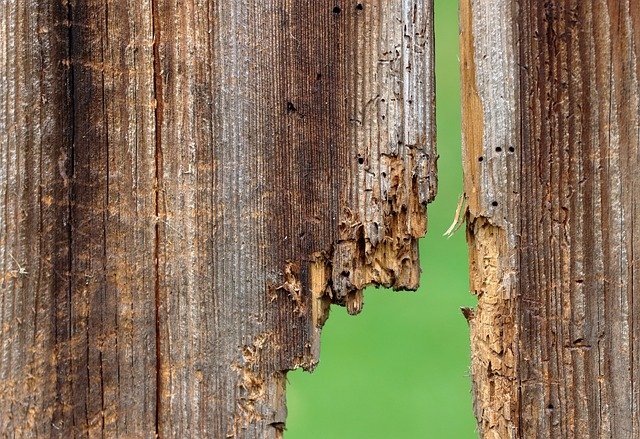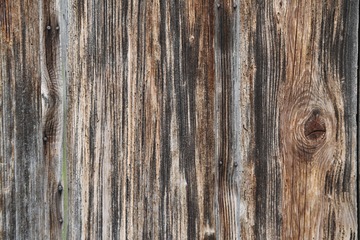Chapter 50 How to Preserve Bonsai Deadwood Features
Every tree species produces a unique type of wood. Some types are very durable and last a very long time without any special care, either because they are very dense (oaks for instance) or contain decay-resistant resin (like cypresses.) Older and closer-grained wood also is more resistant to decay. Other trees like elms, maples and many other broad leaf deciduous species are less decay resistant.
This variety means there is no one-size-fits-all solution to preserving bare wood. However, understanding a few general principles makes it easier to choose the best wood preservation strategy for the situation. The most important thing to remember is that ALL unprotected wood is susceptible to breakdown at some point. Deadwood features will require regular attention in order to maintain them over extended periods.
50.1 Learning from Nature
Looking at what happens to wood “in the wild” can help us replicate the same look while also protecting it.
Wood forms from the cambium layer beneath the bark. As the cambium grows, older portions die, creating a framework that supports the living elements of the tree. Many species secrete resin and secondary compounds that impregnate the oldest, deepest center parts of wood (the heartwood.) These deposits strengthen and make the heartwood more resistant to decay. They also can make the heartwood look darker than the outer layers.

Dark stained heartwood in a freshly cut golden chain tree (Laburnum)._Most trees do not have such an extreme difference in color._ Link to original image.
As long as the outer living cambium and bark remain intact, dead wood inside of a tree is protected from rotting. When the outer bark covering is broken off or dies, the water and resin in the heartwood start to dry out. Initially the wet (also called green) wood is softer and more prone to decay. As the wood dries it shrinks and becomes much harder, in a process known as seasoning. Seasoned wood is more resistant, but still rots eventually.
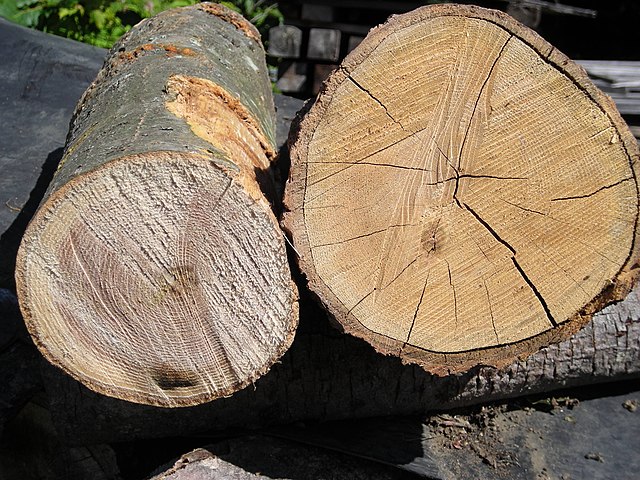
Green wood (left) and seasoned wood (right). Link to original image.
50.1.1 Wood Rot
Decay-causing fungi secrete enzymes and waste by-products that modify the color, texture, and hardness of the wood. Rot-stained wood comes in a wide range of colors: + Bone white to shades of ivory + Yellow, gold, brown + Gray + Nearly black.
Image 1. Buff colored dry rot. Image 2. Orange rot of a conifer log. Image 3. Shades of brown in rotting wood. Image 4. Mixed black fungal decomposition (black) and oxidation (grey). Link to original image 1; image 2, by Matthew Chappell, University of Georgia, Bugwood.org.; image 3; image 4.
Sometimes trees may have a mix of sound wood and rotting wood simultaneously. For example, the outer layers of a branch may be decaying while the inner portion dries out and turns hard.
50.1.2 Oxidation, Photo-Bleaching, and Insects Further Sculpt and Modify Dead Wood
Wood exposed to the elements oxidizes much like metals when they rust, though more slowly. Chemical reactions with water, oxygen, carbon dioxide and sulfur dioxide (acid rain) strip the surface of dead wood. Sunlight (especially UV) further bleaches the wood. These processes create the beautiful ‘weathered’ silvers and grays we associate with old wood. They also change the physical structural properties of the wood, making it more brittle.
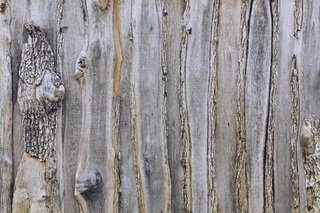
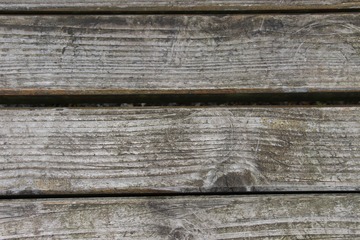
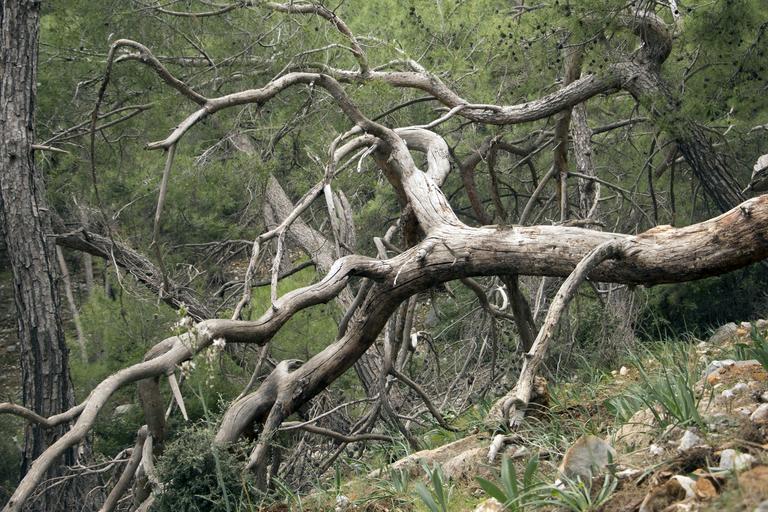


A weathered deadwood trunk. The edges of cracks in the trunk have been smoothed over by weathering and oxidation, softening the look of the wood. Link to original image.
Insects modify dead wood too. For instance ants and wasps often chew away soft rotten wood as a building material for their nests. Other insects will bore into the wood to lay eggs. A small amount of this can add character, but unchecked infestation physically weakens the wood, and also lets water seep into the deeper layers.
50.2 Preserving Deadwood
When preserving wood, ask yourself: what natural features or effects are you trying to recreate? What is the natural color of that feature on full size trees of the species you are styling? Once you have answered those aesthetic questions, ask yourself these four practical questions that can help you decide how to handle deadwood features.
- Is the wood green, seasoned, or already old and weathered?
Usually it is not necessary to preserve newly exposed green wood. The wood will still be sappy and fairly wet, so most preservatives will not penetrate into the wood. Sealing wood that is wet also creates constantly moist conditions that favor rot. Dry wood is both physically harder, and less vulnerable to attack by rot.
Leave newly exposed bare wood to weather for a year so it dries thoroughly and starts to oxidize. Try to keep the wood dry as much as possible. Once the wood has dried and seasoned, treat it with a product that will keep moisture from re-entering and will weather down to the natural colors of bare wood on that species of tree.
In this area it is best to treat seasoned wood in summer, when we tend to have longer dry periods. Clean the wood with a fine bristle brush before applying your chosen product; a tooth brush from a discount store work well. A brass wire brush can be used for more aggressive cleaning.
Once the wood has weathered to a nice white, ivory, or gray apply a transparent preservative annually.
- Is the wood sound, or actively decaying?
It is much easier to preserve sound wood than to stabilize or recover unsound wood. Keeping compromised wood on a tree creates starting points from which rot can spread.
These are some common signs that a tree has unsound wood. You can identify other warning signs that reflect your local conditions by inspecting failing trees or shrubs around your house or neighborhood, or in nearby wood lots.
- Soft, indented spots, particularly where branches were removed. A wooden bamboo chopstick or sharpened pencil point should not be able to penetrate the wood of a tree.
- Ants, especially carpenter ants. They tunnel into weak wood to find food and create nesting space for the colony.
- Wet or discolored spots on the bark not associate with watering.
- Tiny piles of sawdust next to the trunk, indicating attack by wood boring insects.
Wood that has been infected by fungus recently may still have sufficient strength to be saved but wood that is soft or corky is beyond saving and needs to be removed completely. Do not use a plastic wood hardener. They form an impermeable barrier that traps moisture and actually accelerates rot. Instead remove the weakened wood and focus on preventing further breakdown through routine maintenance treatments.
When cleaning away very soft corky decayed wood use a stiff wire brush. Work carefully to avoid removing the sound wood or injuring live tissue.
When “rotted” areas like cavities or hollowed trunks are part of your visual design, you need to carve down to sound wood first, then treat with a tinted preservative to imitate the look of decay.
- What natural features or effects are you trying to recreate? What is the natural color of that feature on full size trees of the species you are styling?
Not all weathered wood is the same color. Regardless of whether weathered wood is a separate element or part of a tree, its color should match what that species develops during natural weathering. Do not assome that all weathered wood looks the same. Weathered wood comes in a wide range of colors, from bone white to shades of ivory, yellow, gold, brown, and gray to nearly black. Colors that look natural on one species will look unnatural on another.
Search online for photos showing old deadwood of your species of interest in its natural habitat, not in bonsai collections. Then choose or adapt the preservation method so the final color looks natural.
- Is the tree you are working on a conifer or deciduous tree?
The approach to resinous wood typical to conifers will be different to that of softer wood typical to deciduous species. For example, lime sulfur is the standard treatment most stylists use to bleach and preserve deadwood on conifer trees. This is not appropriate for a deciduous tree, where a different preservative like boiled linseed oil would be more appropriate.
50.3 Choosing An Appropriate Wood Preservative
Location affects the choice of preservative. Bare wood elements (fallen branches or trunks for example) in a saikei or forest planting need to be treated with a preservative to prevent decomposition. Since these wood elements do not have adjacent living cambium, the primary concern is whether the wood preservative is toxic to nearby trees or plants once it has dried.
Preserving bare wood elements (jin, shari, uro) on live trees presents a different challenge. The preservative used must not be toxic to adjacent live tissues when it is applied, and while it is drying, not just after it dries.
A good example of this problem is tung oil. At first, tung oil seems like an ideal preservative: it is widely available, safe enough to use on food utensils, long-lasting, and derived from a botanical source. While dried tung oil is safe, most commercial tung oil is a 1:1 mix with flammable and toxic solvents like turpentine. The turpentine makes it easier to apply and helps it dry more quickly. However applying it to an open area on a tree trunk will kill adjacent cambium. Keeping well back from the live areas during application is counter-productive, because the gap between the preserved wood and edge of the cambium will be open to rot. Rather than having to constantly monitor the site, it is easier not to use 1:1 tung oil:turpentine and instead use a wood preservative that does not damage the adjacent cambium. The other option is to spend some extra money and buy pure tung oil online.
I can vouch that all of the options I’ve listed below.
50.3.1 Products Appropriate For Preserving Deadwood on LIVE Trees
50.3.1.1 Lime-Sulfur (Calcium Polysulfide)
What most stylists think of as wood preservative. Originally used as a horticultural disinfectant, lime sulfur is very effective at preserving old seasoned wood. Initially it dries bone white, then weathers to a very natural silver that matches the weathered colors of most conifers. Don’t use it on deciduous trees; the color is too stark.
Undiluted lime-sulfur solution is burnt orange. It is corrosive and stinks, so wear protection and work in a well ventilated area. Lightly wet the wood to be treated. Use a paint brush to apply, and work slowly. Wipe the excess away from cambium or off of leaves immediately. Protect pots from splashes; unglazed pots in particular can be badly stained.
Let the lime-sulfur dry thoroughly overnight before exposing to rain.
This treatment needs to be repeated annually.
50.3.1.2 Ferrous Sulfate Wood Preservative
Ferrous sulfate is used to preserve wood that will be allowed to weather rather than being painted. Several “secret old-country family recipe” products for preserving wood have this as their main ingredient. It is non-toxic and does not damage adjacent cambium.
Ferrous sulfate is a better choice that lime sulfur for preserving bare wood on deciduous trees. It does not turn stark white like lime sulfur. Oil paints thinned with linseed oil can be applied over this preservative to adjust the color.
To use:
- Mix 1 tablespoon of ferrous sulfate in 1 quart of water. Avoid breathing the chemical dust.
- Wet the wood you want to turn gray. Large items can be dipped or sprayed using a standard garden sprayer. Keep applying until no more liquid is absorbed.
- Allow to dry before exposing to rain.
Wood will begin to turn gray in 1-3 days. The final appearance may take a couple weeks to establish.
Be careful when using this on oaks or other species that are high in tannins. Ferrous sulfate reacts with tannins and turns nearly black. This can be used to our advantage for coloring and preserving cavities. Tannin is available in small packets from wine-making suppliers or online. Paint a cavity first with tannic acid, then with ferrous sulfate. The cavity will turn nearly black.
Most user guides say ferrous sulfate is effective for several years, but it is a good practice to reapply every 1-2 years.
50.3.1.3 Kaizan Natural Deadwood Preserver and Tree Gum
These two products were developed by Kaizan Bonsai Supply in the UK. Both products worked well as preservatives in both bare wood tests, and when I applied them to trees.
The vendor describes Natural Deadwood Preserver as:
… designed primarily for use with broad leaved species used for bonsai. [It] penetrates deep into the wood killing fungi and bacteria as well as nourishing the wood with natural oils, resins and acids. Best of all once dry it imparts no colour and so the wood ends up looking perfectly natural. The product also allows the wood to breath naturally and so ensures moisture is not trapped deep inside the wood.
Ensure the wood is thoroughly seasoned (no need to apply to recently carved sappy wood). In late spring allow the area to be treated to dry naturally for several days in the sunshine in an airy spot. Once dry apply with a brush liberally until no more solution is absorbed. Repeat again at the end of summer before the onset of winter weather.
During application take precautions to prevent contact with skin and eyes. Use in a well ventilated space. Wash brushes in a concentrated detergent like washing up liquid. Splashes to foliage bark and roots are basically harmless but do try to avoid them. Natural deadwood preserver will not harm pots in any way.
Natural deadwood preserver can also be used for coniferous types of wood but the absorption rate and depth will be less than with deciduous wood. Once dry the woods natural colour will return.
I would suggest using cheap brushes and throwing them out; this stuff does not wash out easily.
Tree Gum is based on the principle that heartwood is richer in resin, making it inherently more resistant to decay. This product is formulated to penetrate wood and replace resins that are lost over time through oxidation and UV breakdown. It also forms a waterproof outer barrier.
To use:
Apply to old well weathered wood, not to recently carved material. Firstly ensure the wood is the color you desire. Tree Gum imparts no color once dry, however following application it will not be possible to change the color of the wood for maybe up to a year.
[A]pply Tree Gum with a large soft brush liberally and quickly to the wood working in one area until no more solution is absorbed. Try to work in a cool shady place. Direct sun will cause Tree Gum to dry before full penetration has occurred. Once the wood is thoroughly soaked the tree can be returned to it’s bench, there is no need to keep the wood protected from rain following application. Repeat application will not be required for at least two years unless the wood is in very poor condition. Any shiny spots that remain after application should be lightly buffed with a wire brush once fully dry.
During application take precautions to prevent contact with skin and eyes. Use in a well ventilated space. Wash brushes in methylated spirit. Splashes to foliage bark and roots are basically harmless but do try to avoid them. Tree Gum will leave marks on pots but these can be cleaned away using methylated spirit.
50.3.1.4 Boiled Linseed Oil
Oil pressed from flax seed has also been used for centuries as a natural wood preservative because of its ability to penetrate deep into porous fibers, and protect wood from moisture and rot. Raw linseed oil is cold pressed then boiled to eliminate protein impurities and improve drying time. Pure linseed oil is non-toxic, and safe to use as a wood preservative in organic garden structures like raised beds, greenhouses and chicken coops.
It contains no solvents, so is unlikely to injure cambium. Still each tree species is different; test its effects on a sacrificial branch if you are not certain.
One of the advantages of using linseed oil is that it can be tinted. Artist’s oil paints were long made by mixing linseed oil with powdered pigments, and grinding them with a specialized glass pestle. That is not necessary for bonsai use. I got excellent results simply by mixing a bit of cosmetics grade green, brown, and black pigments with linseed oil and stirring it til it was smooth. I coated dry-weathered pine branches with the pigment mixes and after they dried, left them out in the elements. After 2 years, none of the pigment has bled out or faded for any of the three color tests.
I would not recommend using commerical oil-based house or trim paints because they may contain toxic pigments or stabilizers. Avoid artist’s colors too, because some contain toxic metals like cadmium or lead.
50.3.1.5 PURE Tung Oil
No I am not contradicting what I said earlier. In 2020 I discovered that pure undiluted tung oil is available online I purchased what is likely a lifetime supply from the Real Milkpaint Company for $30. It is thicker than linseed oil, dries more slowly, and is has a slightly darker color to it. Iin testing I found it works just as well as boiled linseed oil, including fixing pigments for 2+ years (so far).
50.3.2 Preservatives For Wooden Containers, Plywood Bases and Other Bare Wood Items
Containers made from wood and plywood slabs for saikei need to be thoroughly sealed to prevent decomposition. Even pressure- treated wood and marine grade lumber will break down if they stay wet for long enough periods. The products listed below should not be applied to live tissues or deadwood on trees.
50.3.2.1 Tung Oil Plus Solvent
Tung oil is ideal for treating wood objects that will be in direct contact with soil. It does not leach into soil once dry, and is approved for organic uses. The oil seals moisture out of wood and its elastic properties help it provide continuous protection, even as wood expands and contracts in the elements.
50.3.2.2 Pine Tar
Pine tar has been used for hundreds of years to seal and preserve wood, and it’s still used today to seal utility poles, roofs, boats, fences, & below ground wood. It will not leach toxic material into the surrounding soil. Pine tar has either natural or manufactured turpentine as a solvent, which is why it is not suited for use on live branches where it could contact cambium.
50.3.2.3 TimberPro UV
The clear, non-toxic liquid has no odor, and has the consistency of water. It can be easily rolled or brushed onto bare wood.
Timber Pro Internal Wood Stabilizer is a related product that has a chemical reaction with naturally existing free alkali in wood pores. Over time it permanently hardens into silicate glass crystals that fill the pores, and help prevent water from soaking into the wood.
50.3.2.4 Rust-Oleum Woodlife Classic Wood Preservative
This clear formula contains more fungicide than standard sealers or stains, making it a good choice for wood that will remain wet.
50.3.2.5 Marine Spar Varnish
Spar varnish is designed for wooden parts on boats, so must stand up to abuse and continuously wet conditions. However, it does not perform miracles. I found out that even multiple coats will not protect non-pressure-treated interior grade lumber.


